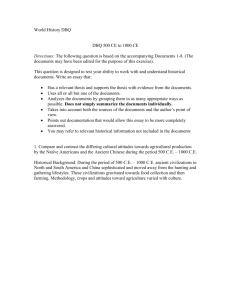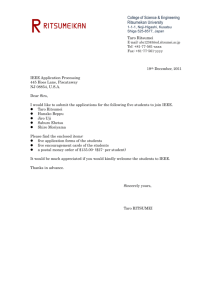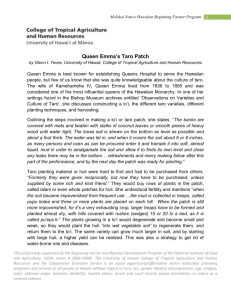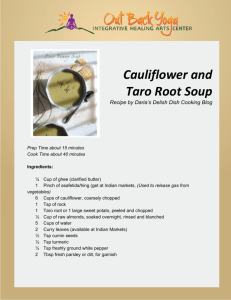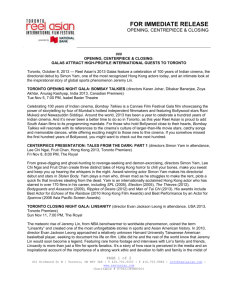Vegetable Crops – Lesson 2
advertisement
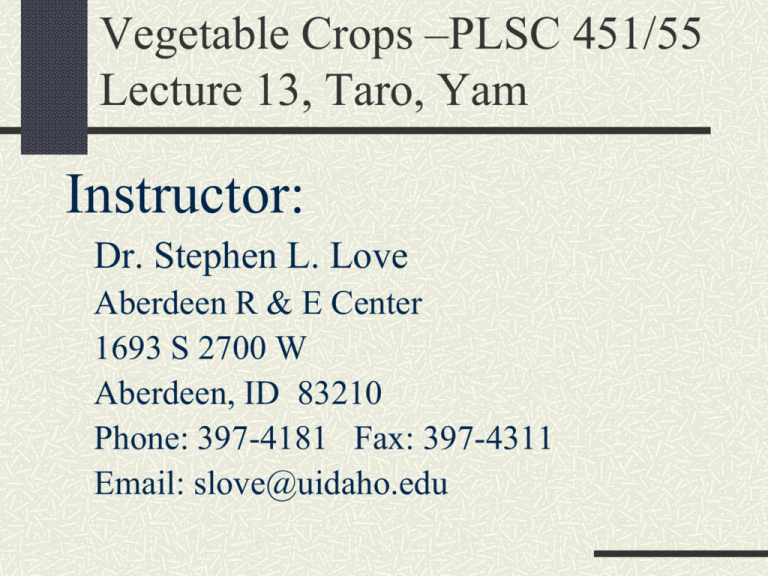
Vegetable Crops –PLSC 451/55 Lecture 13, Taro, Yam Instructor: Dr. Stephen L. Love Aberdeen R & E Center 1693 S 2700 W Aberdeen, ID 83210 Phone: 397-4181 Fax: 397-4311 Email: slove@uidaho.edu Taro field L to R: taro, yam, sweet potato, cassava Taro Also Known As: Dasheen Cocoyam Kolocasi Ocumo Dalo Taro plant (Dasheen) Taro Domestication Probably originated in India or Southeast Asia Taken to China and Japan - 2000 AD Spread to Africa and South Pacific - 500 AD Came to the Western Hemisphere with slaves Yautia (Taro relative) Domestication Also called Tannia Yautia is a related Arum species and is replacing Taro in many African countries Native of tropical America Species name: Xanthosoma sagittifolium Very similar in appearance, culture, use Taro plant Taro corm Taro Production – Climate and soils Tropical Warm-season, very tender Tolerates heavy, clay soils Needs abundant water Can withstand waterlogged soils Optimal pH 6.0-7.0 Tolerates salty water, quick storm recovery Taro Production Systems Very few large producers (Partially mechanized) Virtually no organic production Most production on subsistence and small market farms Taro Production System - Dryland Not ponded Irrigated or planted in the dry season Often intercropped in subsistence production Herbicides commonly employed for weed control Taro Production System - Wetland Ponded or flooded Requires cheap, surplus water Monoculture Herbicides not required Taro Propagation Often propagated from a “huli” Propagules commercially unavailable Nurseries co-produced Hand-planted or machine assisted Taro Harvest Maturity indicated by leaf drop and yellowing Harvest usually by hand No post-harvest curing necessary Store at 45-50 degrees Can be stored for 18 weeks, 2 day shelf-life Harvested taro, ready for market Major Producing Countries China Nigeria Ghana Japan Papua New Guinea 1,320 mt 1,300 1,240 330 220 Considered to be a staple crop in Africa Taro Consumer use Fresh market Boiled or baked Processed Chips, canned, frozen, dehydrated flour used for noodles, cakes and baby food Making poi by mashing taro root Poi made from taro root Taro boiled with fish Boiled taro in coconut milk Thai desert made from taro, beans, and egg yolks Taro Taxonomy Monocotyledon Family: Araceae Genus and species: Colocasia esculenta Related species: calamus, Jack-in-the-pulpit Yam (D. batatas) Yam plant Yam tubers Yam Taxonomy Monocotyledon Family: Dioscoraceae Genus and species: Dioscorea (species) Related species: 250 species of wild yams Yam Species used for cultivation D. alata (greater yam) – SE Asia D. batatas (Chinese yam) – China D. rotunda (yellow yam) – Africa D. esculenta (lesser yam) – SE Asia D. bulbifera (aerial yam) – Africa D. trifida (cush-cush) – Tropical America SE Asia Dioscorea alata (Greater yam) – most widely distributed Africa Dioscorea rotunda (Yellow yam) – greatest production China Dioscorea batatas (Chinese yam) China Dioscorea batatas (Chinese yam) SE Asia Dioscorea esculenta (Lesser yam) Africa Dioscorea bulbifera (Aerial yam) Tropical America Dioscorea trifida (Cush-cush yam) Major Producing Countries Nigeria 27 mil mt Ghana 4 Ivory Coast 3 Benin 2 Togo 0.5 Colombia 0.3 Yam Domestication Used for food in West Africa (probable area of origin) >50,000 years ago Cultivated 3000 BC in West Africa and SE Asia Yam Use and importance Important staple crop in Africa Subsistence production systems Considered to be an under-utilized crop Very high in starch, protein, minerals Yam African peanut and yam soup Consumer use Fresh market Baked, boiled, pounded, fried, dried and ground into flour (Some types must be heavily processed boiled, pounded and leached - to eliminate alkaloids) Yam Unusual compounds Dioscorine – alkaloid in D. hispida and other yams, very poisonous (used as a pest poison) Sapogenin – steroidal alkaloid used in the production of cortisone, progesterone, and other drugs Yam Production – Climate and soils Tropical Warm-season, very tender Will not grow in temps <70 degrees Needs abundant water Requires a well-drained soil Yam Production Propagated using “head” of tubers from the previous crop Six mo to 2 yr growing season Vines are staked and trained Yam Production constraints: Quantity of tubers for seed (30% of production) Quantity of labor to plant, stake, and harvest Tubers are deep and harvest difficult Vanatu vine jumpers Influence on local culture Celebration of harvest, rites to invoke success of a new crop year Yam Production – Diseases and Pests Has very few natural pests Yam Production – Harvest and storage Mostly hand harvested Stored at 55-60 degrees Chilling injury at <50 degrees Ventilation essential Stored for 6-8 months (ambient) Yam storage Jerusalem artichoke flower Jerusalem artichoke tubers Jerusalem Artichoke Domestication Native of North America – found wild in the midwest and northeast Cultivated by the Indians prior to European migration Taken to Europe where it is grown in dry climates Name derived from Italian girasole articocco (sunflower edible) Jerusalem Artichoke Use and importance Similar in appearance and size to Irish potato Very limited usage Storage carbohydrate in inulin (polymer of fructose), useful for diabetics Cooked and eaten in similar manner to potato Jerusalem Artichoke Production Production in specialty market gardens Planted using tuber pieces Planted in fall or very early spring Relative easy to grow Jerusalem Artichoke Production - Misc. Volunteers become weedy Harvested by hand or machine Careful handling necessary if stored Store at 32-36 degrees Can be stored for several months Jerusalem artichoke field
